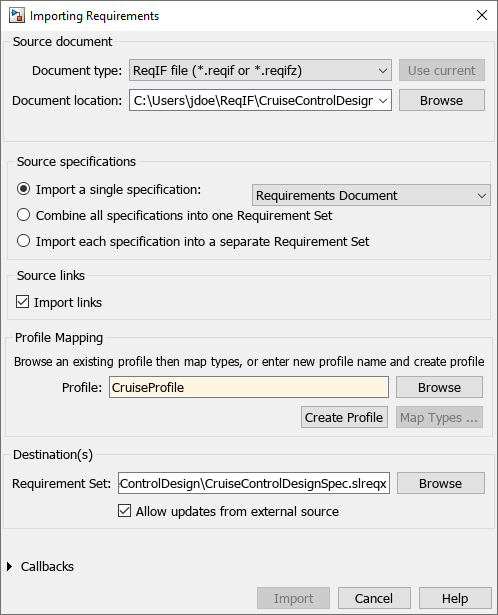从 ReqIF 文件导入时使用原型
当您从 ReqIF™ 文件导入需求和链接时,您可以将 ReqIF 需求和链接类型及属性映射到 Requirements Toolbox™ 原型和原型属性。有关使用 ReqIF 文件导入需求和链接的更多信息,请参阅 从 ReqIF 文件导入需求。
要映射需求和链接类型,请启用需求编辑器在导入期间使用配置文件,然后创建一个新的配置文件。需求编辑器为 ReqIF 文件中的每个需求类型和链接类型创建一个具有原型的配置文件。每个原型都有一个由需求和链接类型定义的属性的属性。或者,您可以使用上次导入期间创建的配置文件,或者使用配置文件编辑器。有关配置文件和原型的更多信息,请参阅 使用原型自定义需求和链接。
导入期间创建配置文件
要导入需求和链接并创建新的配置文件:
通过在 MATLAB® 命令行中输入此命令,允许需求编辑器在导入期间使用配置文件:
rmipref(ReqIfImportUseProfile=true)
注意
此设置在 MATLAB 会话之间持续存在。要在导入期间禁用配置文件,请输入
rmipref(ReqIfImportUseProfile=false)。打开需求编辑器。有关详细信息,请参阅打开 需求编辑器 App。
在文件部分中,点击导入。
在导入需求对话框中,将文档类型设置为 ReqIF 文件(* reqif 或 * reqifz)。
在文档位置旁边,点击浏览并选择 ReqIF 文件。
在配置文件映射部分的配置文件字段中输入新配置文件的名称。

点击创建配置文件。
选择是否允许更新导入的需求。如果您想在第三方工具中管理导入的需求,请选择支持外部源更新,它将需求作为引用需求导入。如果您想将您的需求迁移到 Requirements Toolbox,请清除支持外部源更新。有关导入选项的更多信息,请参阅 选择导入模式。
点击导入导入需求。
注意
您不能导入包含名称非英语语言的枚举的 ReqIF 文件。
有关从 ReqIF 文件导入需求和链接的更多信息,请参阅 从 ReqIF 文件导入需求。
当您导入需求和链接时创建新的配置文件时,Requirements Toolbox:
将配置文件分配给导入的需求集和链接集
为每个 ReqIF 需求类型和链接类型创建原型
为每个 ReqIF 需求属性和链接属性在原型中创建原型属性
将原型映射到 ReqIF 需求类型和链接类型,并将原型分配给导入的需求和链接
将原型中的原型属性映射到 ReqIF 需求和链接属性,并将属性值作为原型属性值导入
有关原型的更多信息,请参阅 使用原型自定义需求和链接。
在导入期间以编程方式创建配置文件
自 R2023b 起
您还可以使用 slreq.import 函数以编程方式导入需求和链接并创建新的配置文件。使用 profile 名称-值参量来指定新配置文件的名称。
此代码从名为 myReqs 的 ReqIF 文件导入需求和链接,创建一个名为 myProfile 的新配置文件,并将该配置文件分配给导入的需求集和链接集。代码输出导入需求的数量、导入需求集的文件路径、以及导入需求集对象的句柄。
[count,path,myReqSet] = slreq.import("myReqs.reqif", ... profile="myProfile",importLinks=1)
导入时使用现有配置文件
要在导入需求和链接时使用现有配置文件:
在“导入需求”对话框中,在配置文件映射部分中,点击浏览并选择一个配置文件。
通过点击映射类型,将 ReqIF 需求和链接类型及属性映射到现有配置文件中的原型和原型属性。
在“映射”对话框的左侧窗格中,选择 ReqIF 需求类型或链接类型。

在右侧窗格中,将映射的原型设置为您想要映射 ReqIF 需求或链接类型的原型。为了防止 Requirements Toolbox 导入所选类型的需求或链接,请将映射的原型设置为 [Ignored]。
通过将原型属性设置为所需的 Requirements Toolbox 属性或原型属性,将每个 ReqIF 需求或链接属性映射到内置属性或原型属性。为了防止 Requirements Toolbox 导入需求或链接属性值,请将该属性的原型属性设置为 [Ignored]。
点击确定。
在导入需求对话框中,点击导入。
要将映射保存到 XML 文件以便重复使用,请在“映射”对话框中点击保存映射。要加载现有的配置文件映射,点击加载映射。
导入期间以编程方式使用现有配置文件
自 R2023b 起
当您使用 slreq.import 函数以编程方式导入需求和链接时,您还可以使用现有的配置文件。使用 profile 名称-值参量来指定现有配置文件的名称。
此代码从名为 myReqs2 的 ReqIF 文件导入需求和链接,并将现有配置文件 myProfile 分配给导入的需求集和链接集。
[count,path,myReqSet] = slreq.import("myReqs2.reqif", ... profile="myProfile",importLinks=1)
slreq.import 函数将 ReqIF 需求和链接属性映射到 Requirements Toolbox 中的原型和原型属性。使用 profileMapping 名称-值参量指定要使用的配置文件映射 XML 文件。此代码从名为 myReqs2 的 ReqIF 文件导入需求和链接,将名为 myProfile 的现有配置文件分配给导入的需求集和链接集,并根据配置文件映射文件 myProfile 将 ReqIF 属性映射到 myMapping.xml 配置文件中的原型和原型属性。
[count,path,myReqSet2] = slreq.import("myReqs2.reqif", ... profile="myProfile",importLinks=1,profileMapping="myMapping.xml")
提示
要创建配置文件映射 XML 文件,请使用以下方法之一:
当您使用需求编辑器从 ReqIF 文件导入需求时,在配置文件映射对话框中,点击保存映射。
从 ReqIF 文件导入需求后,在需求编辑器中选择导入节点。在右侧窗格中的 ReqIF 配置文件映射下,点击保存映射。
使用
slreq.find获取导入需求集的句柄,然后使用saveProfileMapping函数。
调整配置文件映射
您可以通过选择导入节点并在右侧窗格中点击 ReqIF 配置文件映射下的查看映射来查看 ReqIF 需求和链接数据与需求编辑器中的 Requirements Toolbox 原型之间的映射。

映射对话框中的映射是只读的。

要调整配置文件映射,请注意应用于需求集的配置文件。关闭需求集并使用相同的配置文件重新导入。按照 导入时使用现有配置文件 中所述映射原型。